| Jan 06, 2022 | |
Cotton, PLA-phytochemical encapsulated nanofiber-based face mask for combating the spread of COVID-19 infections |
|
| (Nanowerk Spotlight) The fateful origin of the Covid-19 pandemic since the beginning of 2020 has taken a heavy toll on human lives and health with more than 280 million infections and more than 5.4 million deaths reported worldwide as of late December 2021 (as per WHO Coronavirus (COVID-19) Dashboard). | |
| To protect against a Covid-19 infection, people (unvaccinated & vaccinated) are urged to wear a face mask, and frontline workers and medical staff to wear personal protective equipment (PPE) suits. | |
| These face masks and PPE suits based on synthetic polymer (mostly polypropylene and polyester) are very effective in protecting their wearer against COVID-19 infections, but after their use they are usually thrown away by people in developing countries, and in most of the developed countries, they are collected in specially sealed waste bin containers and then disposed of as biowaste. | |
| Openly discarded synthetic face masks, which are non-biodegradable in nature, further act as a secondary source of infection. When these synthetic face masks and PPE suits get buried in soil, they obstruct ground water percolation and impact soil fertility due to their non-biodegradable nature. Also, when these unhygienically discarded masks get into open water sources like ponds, rivers, the sea, etc., they can create toxicity to aquatic animals and the aquatic environment. | |
| Researchers estimate that 6.88 billion (weighing approximately 206,470 t) face masks are used around the world each day, which ultimately are incinerated, sent to landfills or simply dumped in the environment, providing a glimpse of a forthcoming severe global environmental crisis. | |
| Thus, there is a critical need for effective yet environmentally friendly (i.e. biodegradable) bio-based materials for face masks and PPE suits that avoid causing harm to surrounding environments. | |
| Considering these urgent research needs, our group has developed a 3-layered (i.e. cotton-PLA-cotton) biodegradable face mask exhibiting encapsulated herbal-extracts in the inner fibrous filtration layer. | |
| The inner filtration layer was fabricated using needleless electrospinning of Polylactic acid (PLA) tailored with herbal-extracts. This 3-layered face mask exhibited air permeability (differential pressure of 35.78 Pa/cm2) as per IS-16289-2014 Annex C standard and excellent bacterial filtration efficacy of 97.9% as per IS-16289-2014 Annex D standard. The close-packed structure of the electrospun nanofiber filtration layer could filter particulate matter, aerosol particles, and bacteria (Figure 1). The top layer of the cotton and middle layer of nanofibrous PLA of the face mask reveal porous, rough, heterogeneous textured surface morphology. | |
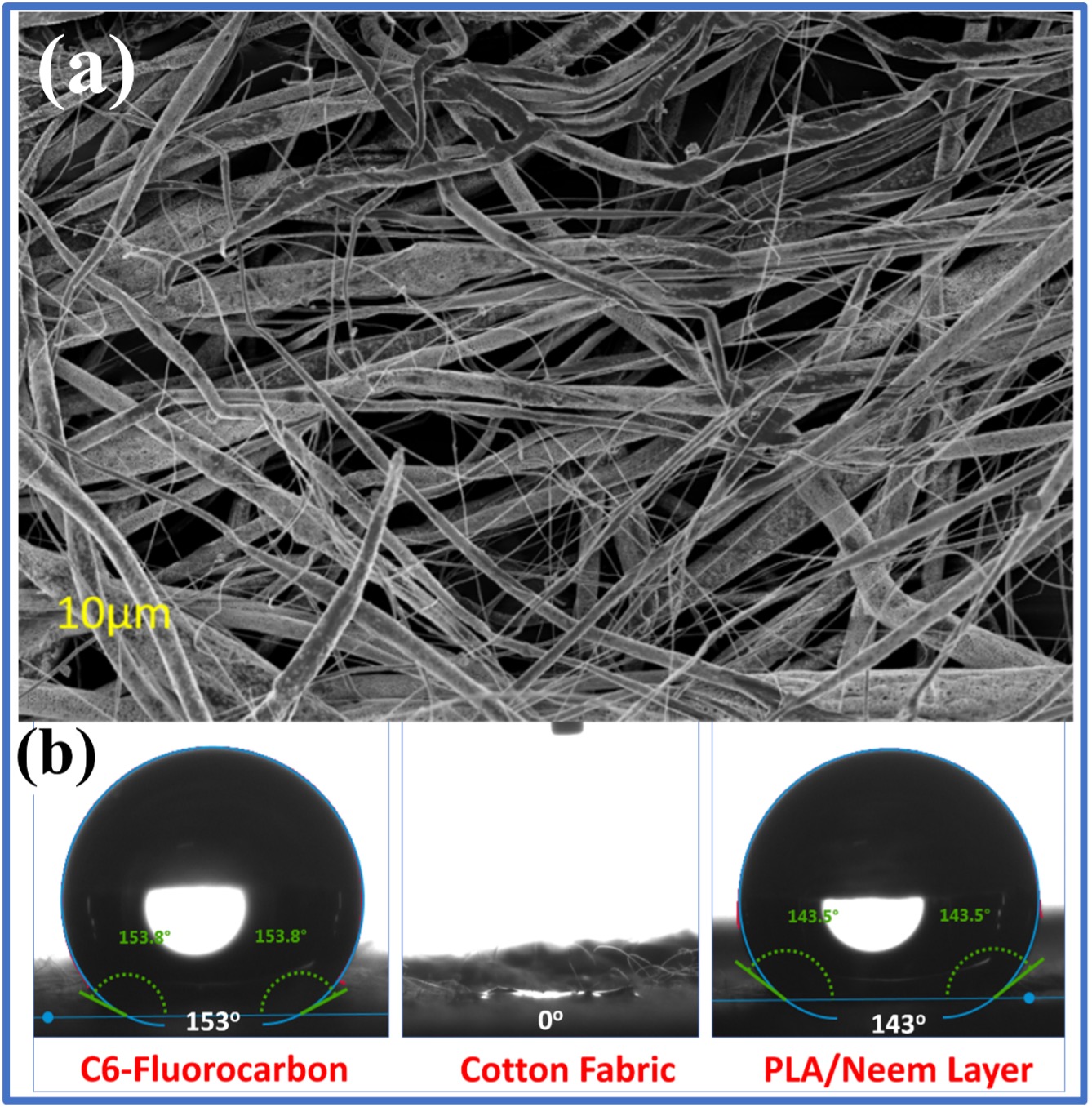 |
|
| Figure 1. Face mask (a) surface morphology, and (b) superhydrophobic nature. (Reproduced with Copyright permission from Chemical Engineering Journal, 2021, 416, 129152) | |
| The face mask's outer surface layer was coated with hydrophobic C-6 fluorocarbon, which exhibited efficient blood splash resistance up to a distance of 30 cm, confirming its application for personal safety and protection in the pandemic (Figure 2). | |
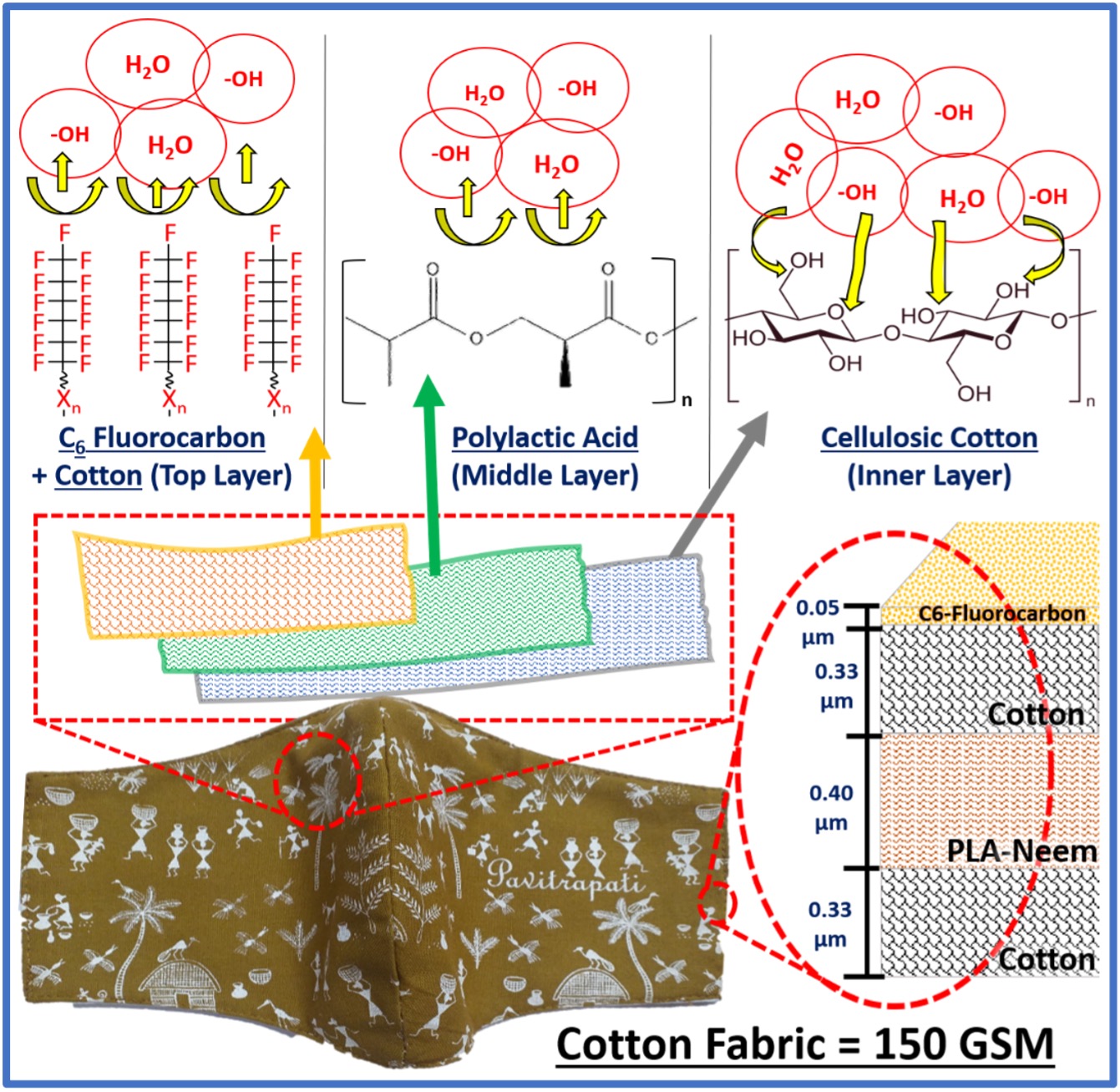 |
|
| Figure 2. Different filtration layers, and surface chemistry of the face mask. (Reproduced with Copyright permission from Chemical Engineering Journal, 2021, 416, 129152) | |
| The cotton and PLA demonstrated effective biodegradability in the in-house developed cow-dung based biodegradation slurry, which consists of various bacteria (around 60), subjugated by Corynebacterium sp., Bacillus sp., Lactobacillus sp., Aspergillus, and Trichoderma. These bacteria help in enhancing the biodegradation rate and composting action on the cotton, and PLA polymers of the face mask (Figure 3). | |
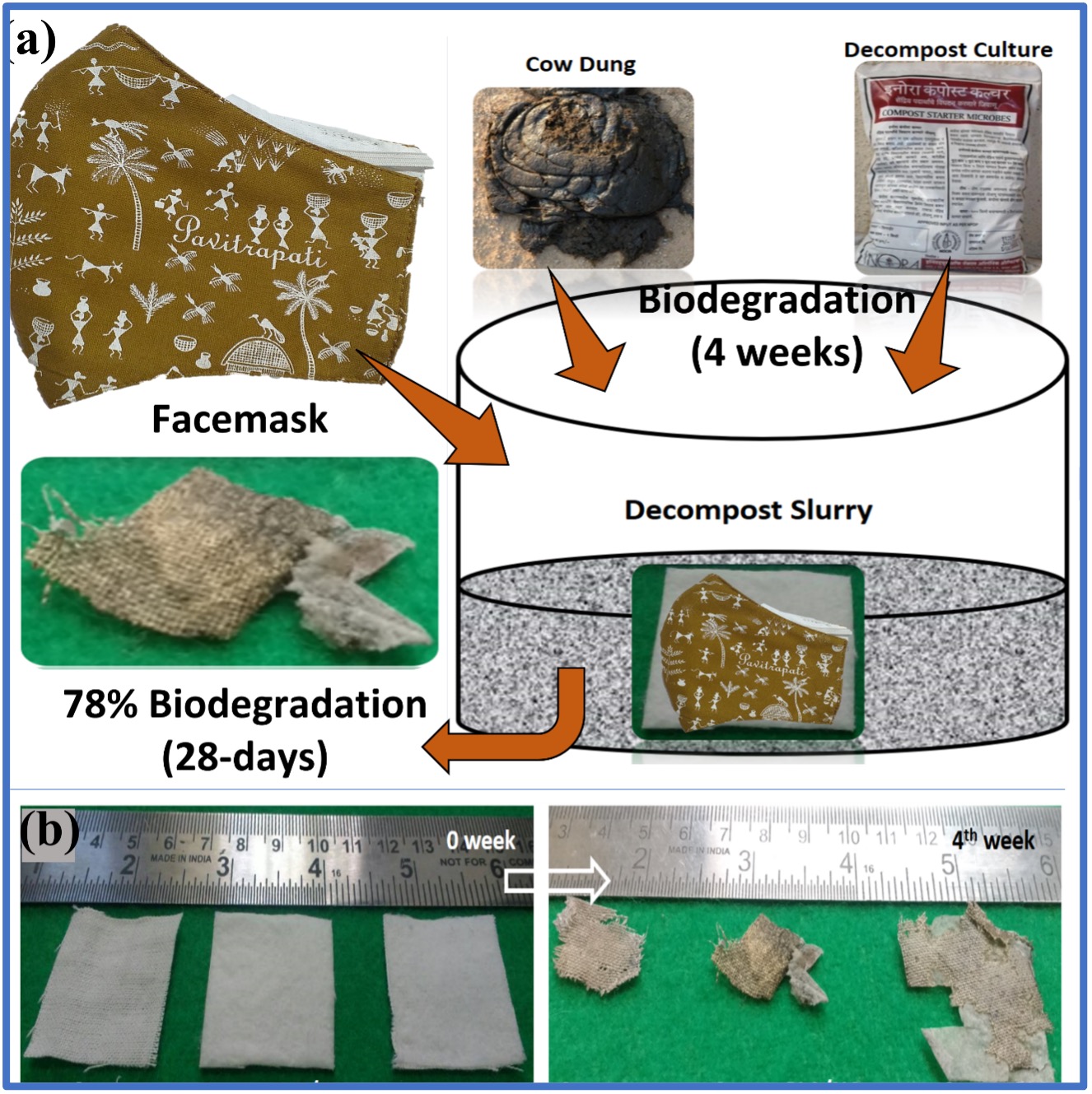 |
|
| Figure 3. Biodegradation performance of face mask (a) biodegradation set up, and (b) biodegraded samples. (Reproduced with Copyright permission from Journal of Materials Chemistry A, 2018, 6 (17), 7457-7479) | |
| The computational analysis of herbal phytochemicals using the scoring function based LibDock algorithm, showed the specific binding sites of the protein-ligand complex and their structural characteristics of the phytochemicals against various bacteria (Figure 4 & 5). | |
| Docking performance evaluates the structural compatibility of chemical ingredients to neutralizing capabilities of herbal extracts. The selection of the bacteria was based on its activity to spread the infections of the COVID-19 virus. The neutralizing capability of the chemical constituents was attributed to the excellent docking performance and interaction of the herbal-phytochemicals during the unfolding of the protein structure. | |
| The higher docking score of Nimbin and Mahmoodin (these are major triterpenoids contained in Neem oil herbal extract) against the 2YA4-Neuraminidase (NA) protein from Streptococcus pneumonia bacteria was attributed to the presence of hydrogen bond acceptor, which enhances the hydrogen bonding between the protein-ligand complex due to the attraction between acceptor's positive charge and electron lone pair on the other atom. | |
| Computational simulation of constituent herbal-extract nanoparticles using the LibDock algorithm indicated inhibitory action against the protein-based bacteria and viruses, which was also attributed to the presence of oleic acid, stearic acid, linoleic acid, and arachidic acid in the herbal extracts. | |
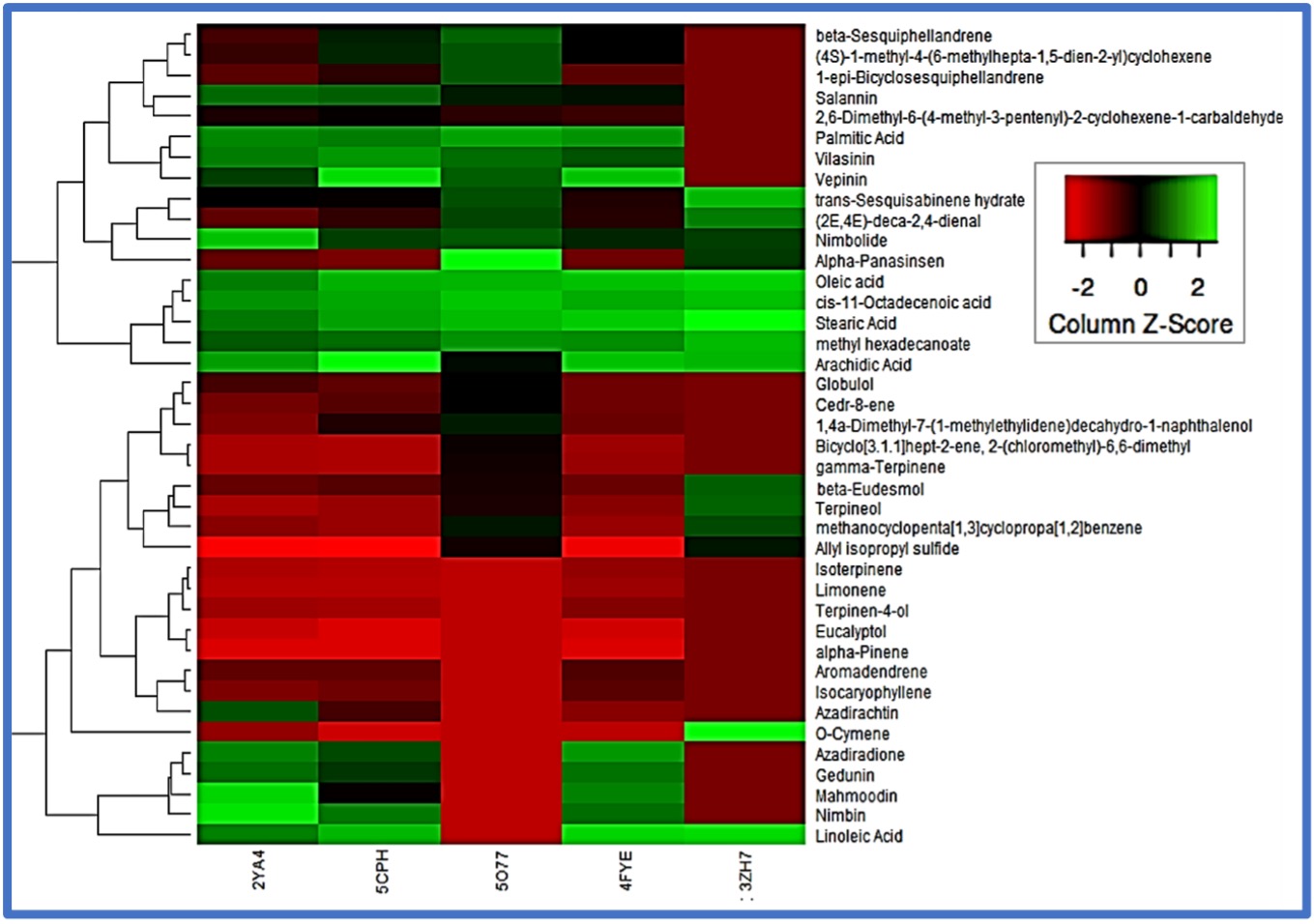 |
|
| Figure 4. Computational analysis of encapsulated herbal extracts against infectious bacteria and viruses. (Reproduced with Copyright permission from Chemical Engineering Journal, 2021, 416, 129152) | |
| Diffusion of herbal phytochemicals occurs in low concentration (for safe inhalation as per international standards) through fiber layers and its subsequent inhalation helps in improving the immunity-boosting, with comfortable feeling e.g. Vicks inhalers, to the mask bearing person. | |
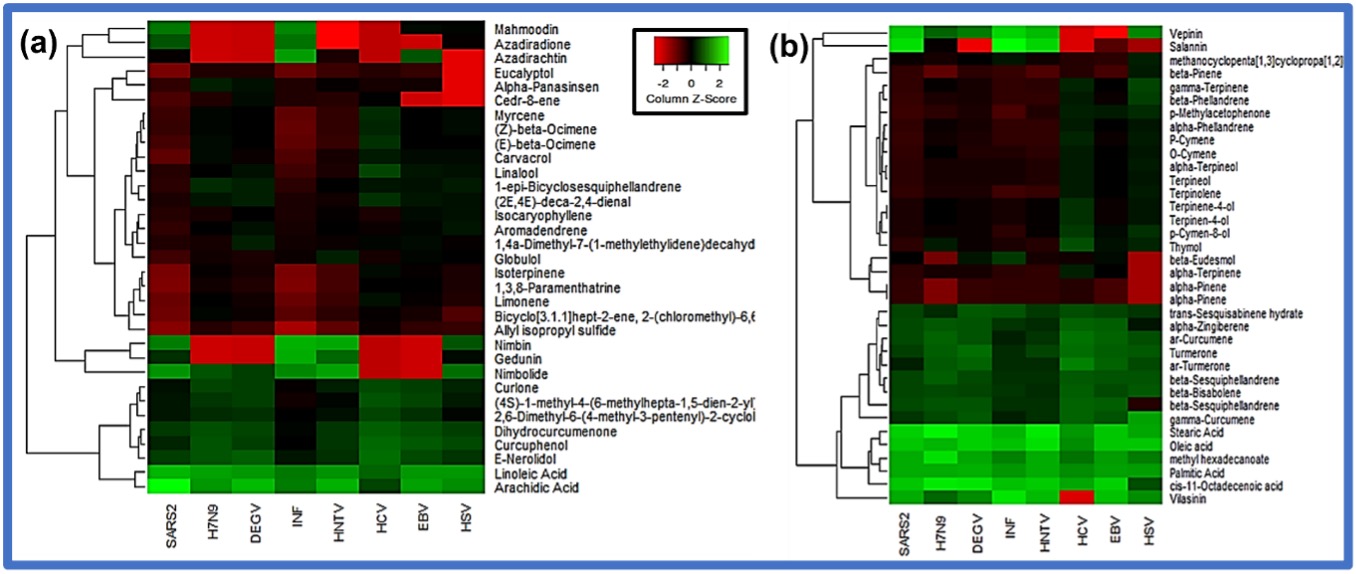 |
|
| Figure 5. Heat map analysis of major constituent chemicals in the herbal extract-based formulation (A) against airborne viruses (such as SARS-CoV-2 virus, (B) H7N9-Drug-resistant Influenza A, DEGV- Dengue virus, INF- Influenza, HNTV- Hantavirus, HCV-Hepatitis C, EBV- Ebola, HSV-Herpes simplex). (Reproduced with Copyright permission from Chemical Engineering Journal, 2021, 416, 129152) | |
| Higher docking score of salanin, arachidic acid, stearic acid, and palmitic acid to counter the protein structure of SARS-CoV-2 virus was attributed to the existence of hydrogen-bond acceptor and aliphatic chains as it augments hydrogen-bonding within protein-ligand compound due to attraction between electron lone pair and acceptor's positive charge. | |
| Aliphatic structure leads to efficient spin of bonds for occupying the targeted binding location, thereby improving the docking performance of constituent chemicals for countering the protein structure. Neutralizing performance of stearic acid to counter the protein folding of H7N9 virus was aided due to presence of hydrogen bond acceptors. | |
| Similarly, the confined performance of cis-11-octadecanoic acid and arachidic acid to counter the protein structure of Dengue virus was attributed to its aliphatic structure of constituent herbal extracts, leading to efficient binding performance at targeted protein interface. Structural compatibility of salanin against Influenza virus demonstrated an optimal docking score, resulting in improved binding of ligands structure against the protein structured binding sites. Hindered performance of oleic acid and stearic acid was significant due to structural compatibility of constituent chemicals to counter Hantavirus. | |
| Structural attributes of palmitic acid, stearic acid, and oleic acid, against Hepatitis C virus demonstrated enhanced docking score leading to enhanced binding of ligand molecules across the protein structures. The neutralizing performance of oleic acid and linoleic acid was substantial for demonstrating structural compatibility against Ebola virus and Herpes simplex virus. Computational analysis indicated antibacterial performance of herbal phytochemicals to counter the protein structured virus, for curbing the spread of viral and bacterial infections during pandemic situation. | |
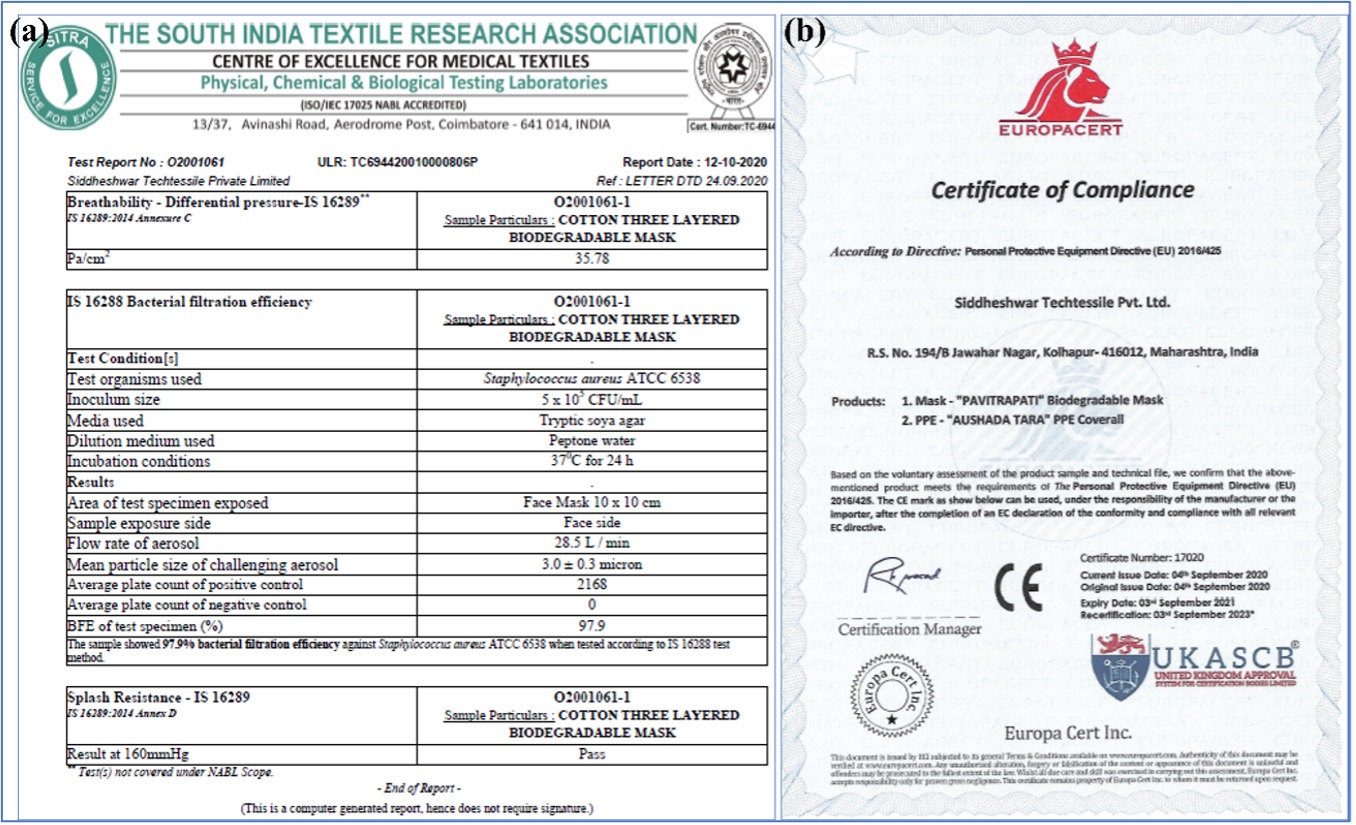 |
|
| Figure 6. (a) Commercial splash resistance and bacterial filtration efficiency test, and (b) CE certification of the developed face mask. | |
| The developed face mask was certified (CE certification) from the European Commission for sale across the European Union member countries (Figure 6). The developed face mask's transfer-of-technology (ToT) and NDA documents, were transferred free of charge to Indian technology companies like Siddheshwar Techtessile Pvt. Ltd. Kolhapur, Venus Safety and Health Pvt. Ltd. Mumbai, Mandava Textiles Pvt. Ltd. Andhra Pradesh, under the national 'Make in India' initiative, and for combating the spread of the COVID-19 pandemic (Figure 7). | |
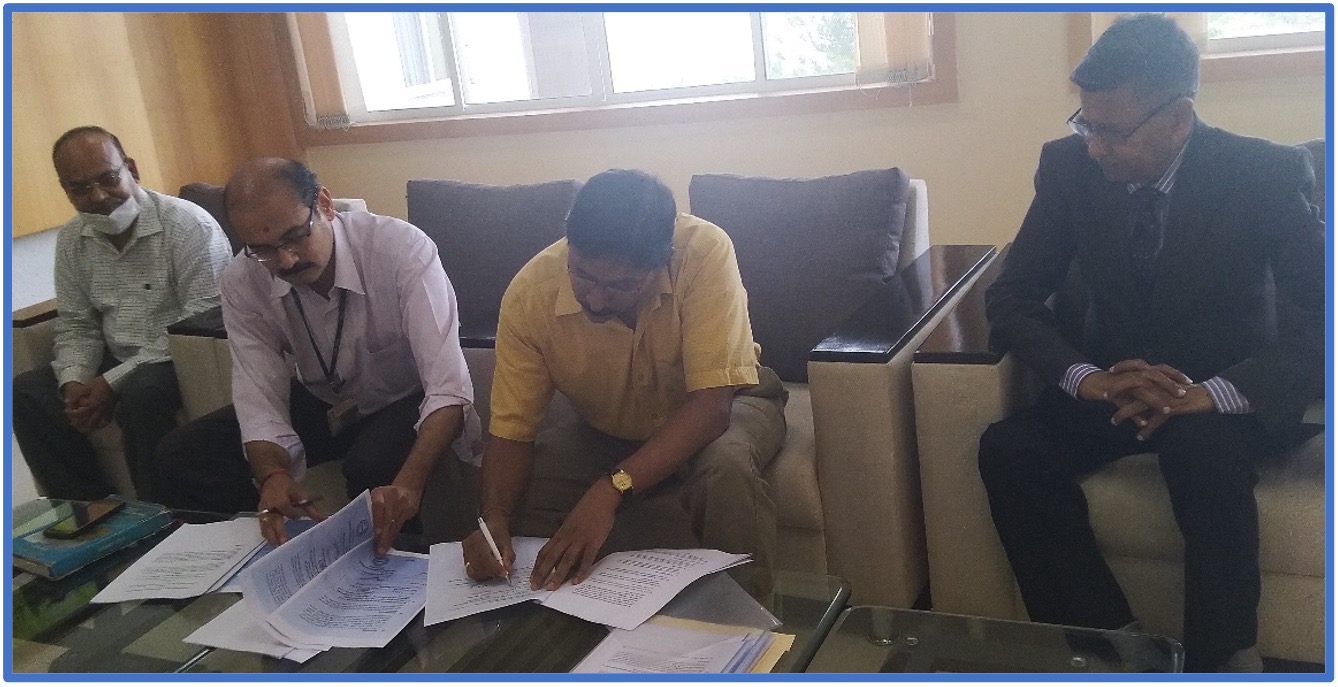 |
|
| Figure 7. Prof. Balasubramanian K., Principal Investigator of face mask project, and The Vice-Chancellor of DIAT (DU) signing ToT, and NDA documents to the Indian technology companies and start-ups. | |
| Siddheshwar Techtessile Pvt. Ltd. Kolhapur sold around one million units of the face mask worldwide, and the Venus Safety and Health Pvt. Ltd. Mumbai developed a synthetic variant product named 'V-Shwas' which is a FFP3 class face mask with 98.9% bacterial filtration efficacy and is approved as per ISI's IS-9473 standard for sale across India (Figure 8). | |
 |
|
| Figure 8. Launched products on the developed face mask technology. (Reproduced with Copyright permission from Venus Safety & Health Pvt. Ltd.) | |
| As a social responsibility, and the national cause, DIAT (DU) had organized the distribution of face masks (Figure 9) free of cost from the received royalty to social NGO's, orphanages, frontline workers of Government hospitals, and the servicemen of Indian Army, Indian Navy, and Indian Airforce, under the supervision of Principal Investigator, Prof. Balasubramanian K., who spearheaded the entire project and development of this unique face mask technology. | |
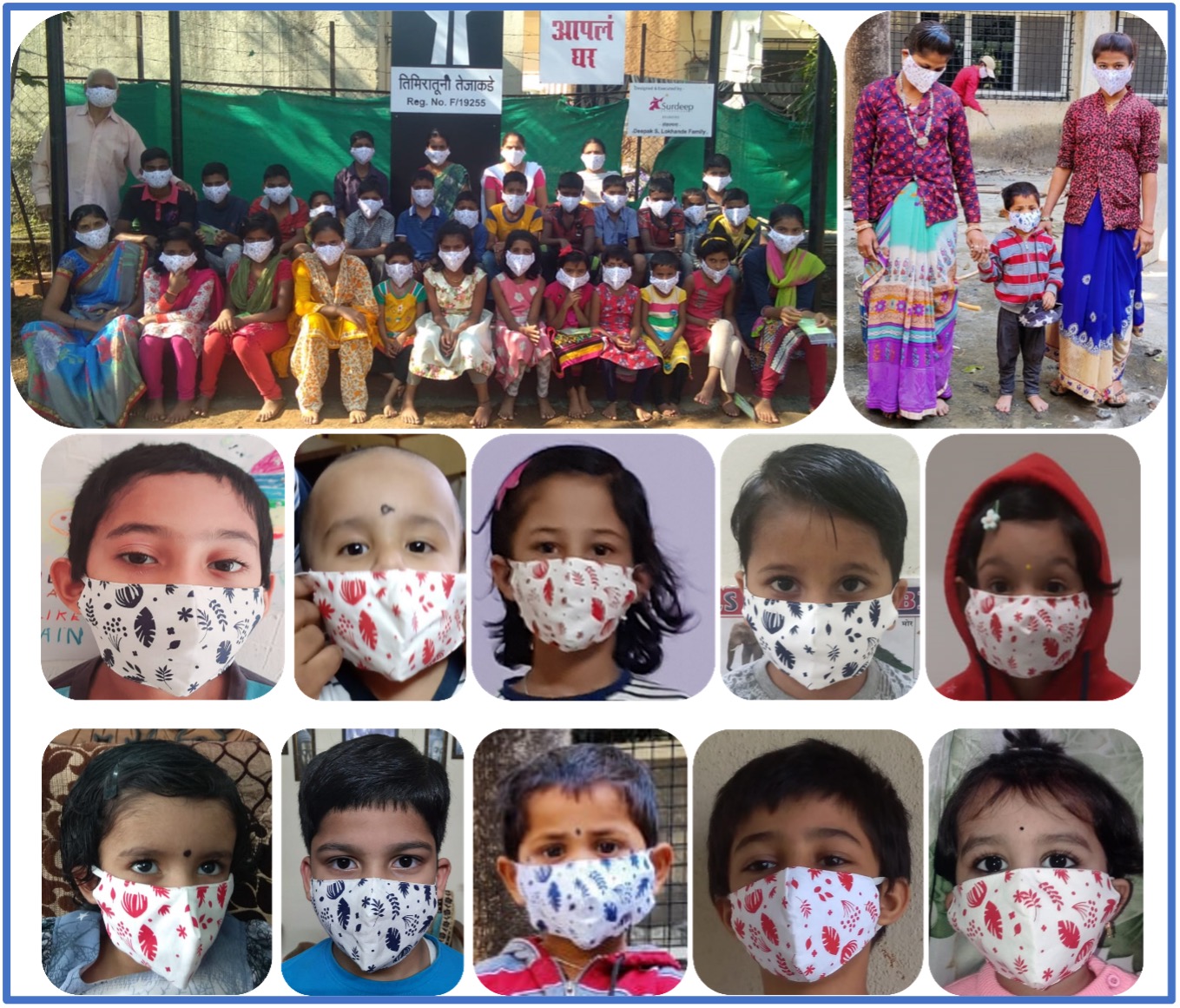 |
|
| Figure 9. Social responsibility initiative of DIAT (DU) with face mask distribution to the NGO's, children, frontline workers of Government hospitals, and servicemen. | |
References |
|
| (1) NA Patil, PM Gore, NJ Prakash, P Govindaraj, R Yadav, V Verma, D Shanmugarajan, S Patil, A Kore, B Kandasubramanian, Needleless electrospun phytochemicals encapsulated nanofibre based 3-ply biodegradable mask for combating COVID-19 pandemic, Chemical Engineering Journal, 2021, 416, 129152. | |
| (2) NA Patil, PM Gore, D Shanmugrajan, H Patil, M Kudav, B Kandasubramanian, Functionalized non-woven surfaces for combating the spread of the COVID-19 pandemic, Interface Focus, 2021, 12 (1), 20210040. | |
| A Nanowerk exclusive provided by Prof. Balasubramanian K PhD(UK), C Eng(UK), DEAN, Professor of Metallurgical and Materials Engineering DIAT(DU), Ministry of Defence, Girinagar, Pune, India | |
|
Become a Spotlight guest author! Join our large and growing group of guest contributors. Have you just published a scientific paper or have other exciting developments to share with the nanotechnology community? Here is how to publish on nanowerk.com. |
|
